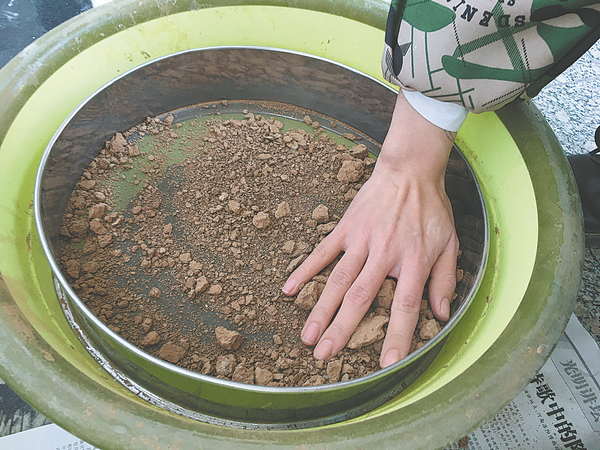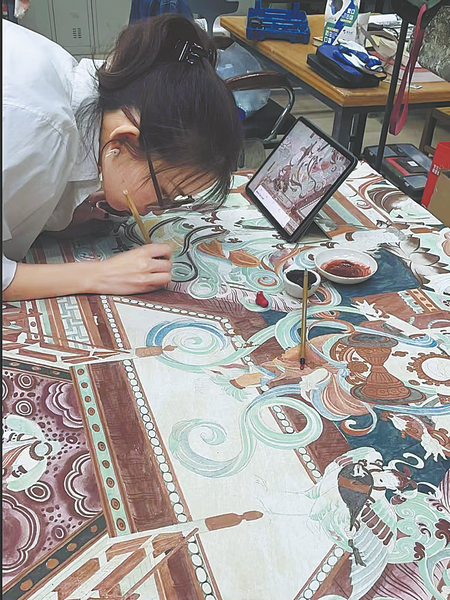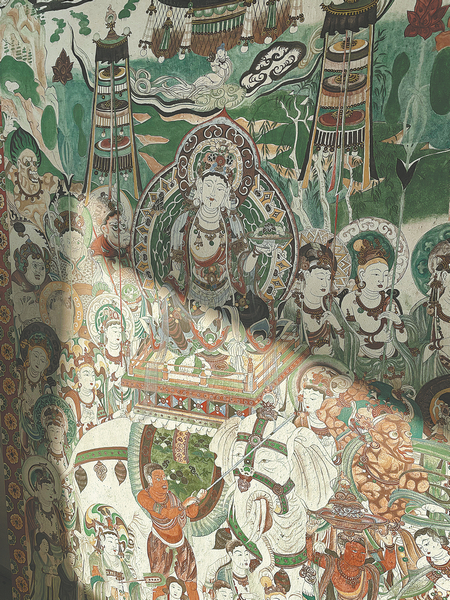
Qin Yueyu, 27, from Anhui province, works in a classroom at Shandong College of Arts in Shandong province. She has brought stunning murals closer to the public with her meticulous reproductions. CHINA DAILY
Mural reproduction boosts online popularity and sees her fame grow, as technique and attention to detail wins many admirers, Yang Feiyue reports.
Qin Yueyu has managed to fulfill a dream that initially seemed outlandish. Simply put, it was to create a copy of a mural from the ancient past and view it at home, at leisure.
Her meticulous replica based on the stunning imagery at the Mogao Grottoes in Dunhuang, Northwest China's Gansu province, has created a sensation on the internet, making her an online celebrity.
Qin's magnum opus that was brought to public attention was initially meant to be displayed for her graduation.
"I wanted the work that concluded my school life to be magnificent and carry some nice connotations," she says, talking about her preparation of the work in June last year.
It runs 2.1 meters high and is her re-creation of part of the mural in Cave 159 of the Mogao Grottoes.
"Cave 159 is a piece from the middle of the Tang Dynasty (618-907) and is representative of the classic style," Qin says, adding that it features Samantabhadra bodhisattva riding on a six-tusked white elephant, symbolizing morality and virtuous conduct.
"Some of the images in the painting are the inspiration for the facial makeup of traditional operas."
Qin restored every vivid detail of the mural, "warts and all".
"I also made sure its size was in the same range as the original," Qin says.
The work displays the color application in the manner of the period, a sweeping style and meticulous craftsmanship. The predominance of blue and green renders an elegance and delicacy.
"From those murals, we can see the lifestyle of ancient people and their infinite imagination," she says.
Qin's work made its way to the list of trending topics on social media platform Sina Weibo at the end of May. She has also attracted more than 10,000 followers to her personal account on Xiaohongshu, another social media platform, and her work has been avidly sought after by her new fans.
"I can get by for now, being a freelancer," she says, adding that a couple of months ago, she was a bit worried about finding a job, and even had thoughts about changing her career.
For the past three years, the 27-year-old from East China's Anhui province studied cultural relic protection and restoration at the Shandong College of Arts.
Out of curiosity, Qin focused on ancient mural reproduction and protection for her postgraduate program, a highly unusual and little-known area of study. "Even some of my schoolmates might not have heard of it," she says.
It also meant relatively fewer job opportunities, especially amid the COVID-19 pandemic.
But rave reviews from online fans boosted her confidence.
"It has reassured me that I didn't choose the wrong major," Qin says.
"It is just that not many people opted for it, and I have to work hard to deliver an end product that stands out and speaks for itself."
Qin developed an interest in painting at the age of 6 and she loved to show her perspective of the world with marker pens.
Then, the cartoon Nine-Colored Deer produced by Shanghai Animation Film Studio in 1981 predisposed her to the charm of Dunhuang.
The strong elements of Chinese painting, magical animals and stunning Dunhuang scenery in the cartoon left a big impression on her. "I became curious about Dunhuang and more interested in art," she recalls.
When most of her peers were busy preparing for college entrance examinations in senior middle school, Qin decided to take a different path. "It meant I had to leave school and take full-time art training for a year, off campus," she says, adding that her determination persuaded her parents that their worries about her future were unfounded, ultimately winning their support.
Qin proved herself a woman of her word and, for the following year, spent more than 10 hours a day learning and practicing various painting skills, including sketching and gouache.

After digging soil on the lakeside, Qin crushes it into pieces, sifts it to obtain a fine earth and makes a drawing board with it, then paints on it to re-create murals from the ancient past, such as those at the Mogao Grottoes in Dunhuang, Northwest China's Gansu province. CHINA DAILY
"All I could remember about that time was the lack of sleep," she recalls.
In 2013, Qin was admitted to the Shandong University of Art and Design and focused on artwork appraisal and restoration.
She picked up culture and art history, as well as cultural relic and archaeology theories. At the same time, she honed practical skills of restoring ancient books, bronzes and ceramics.
She used to go to the flea market to purchase old books and repaired them using complex and meticulous processes.
She had to find paper of a similar color and texture to mend worm-eaten pages, before removing the dirt, flattening them out and binding them up with threads.
"The key is to not leave any trace of repair work," Qin says, adding that, at first, she was clumsy and had to work longer hours to grasp the necessary skills.
The experience further exposed her to the beauty of ancient art. "It has all laid a foundation for me to better understand the styles and characteristics of books and paintings from different historical periods, thus enabling me to produce more accurate artwork," Qin says.
After finishing her undergraduate education in 2017, Qin worked at a private art museum in Hangzhou, capital of East China's Zhejiang province.
The job enabled her to meet many artists, whose understanding of art further opened her eyes. "Their perceptions toward aesthetics were inspiring," Qin says. "I realized there was more I could learn."
After saving enough money for tuition and an intense four-month preparation for the postgraduate school tests, Qin secured enrollment to the Shandong College of Arts in 2019.
Along with two other students, she settled on ancient mural reproduction and protection.
"The professor offered us theoretical knowledge and then encouraged us to try it on our own," she says.
In the beginning, Qin struggled with every step of mural reproduction.
"You need to create a drawing board made of soil to emulate the grotto wall," Qin says.
But climate and soil quality vary by region, so experiments had to be conducted, she adds. "Otherwise, the soil board might crack or exhibit other problems."

After digging soil on the lakeside, Qin crushes it into pieces, sifts it to obtain a fine earth and makes a drawing board with it, then paints on it to re-create murals from the ancient past, such as those at the Mogao Grottoes in Dunhuang, Northwest China's Gansu province. CHINA DAILY
She dug soil on the lakeside, crushing it into pieces and sifting it to obtain a fine earth.
Then, the painting part begins. "The only way is to practice over and again, and learn from your mistakes," she says.
Through trial and error, Qin continued perfecting her skills and has reproduced dozens of well-known murals from the Yongle Palace of Shanxi province, the Fahai Temple of Beijing and the Kizil Grottoes in the Xinjiang Uygur autonomous region. "They all are the cream of the crop among ancient Chinese murals and an indispensable part of learning traditional painting," Qin says.
When Qin decided to reproduce the mural from the Cave 159, she didn't expect that it would take six months. "The complexity was a bit beyond my expectations," she admits.
To start with, the size of the painting was a problem. "The stakes are high when it comes to working on big paintings, which are more difficult to transport and easier to break," Qin explains.
Ingeniously, she developed a thin soil-based board to minimize the risks.
The painting process itself was not exactly plain sailing, either.
Li Jimin, Qin's postgraduate supervisor, says: "Painting an ancient mural is demanding both in terms of the brain and brawn."

After digging soil on the lakeside, Qin crushes it into pieces, sifts it to obtain a fine earth and makes a drawing board with it, then paints on it to re-create murals from the ancient past, such as those at the Mogao Grottoes in Dunhuang, Northwest China's Gansu province. CHINA DAILY
"Students of ancient mural reproduction and protection need to stay composed," Li says.
More young people like Qin are needed to popularize traditional Chinese culture, according to Wang Dahai, head of the School of Urban Arts and Creativity at the Shandong College of Arts.
Qin felt very lucky that she can "now make a living" by doing something she likes, adding that the postgraduate study has deepened her understanding of beauty.
"Chinese people especially love the historical charm that lies behind various items," Qin says, adding that she is glad that her efforts have helped popularize the murals.
"I hope I can tap into more stories about Dunhuang and present them in my future works."
Address:https://enapp.chinadaily.com.cn/a/202207/06/AP62c4d6bfa3104446d8d1cab2.html
